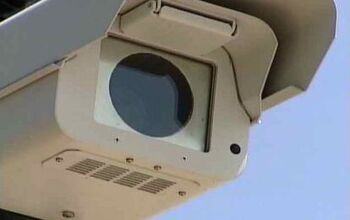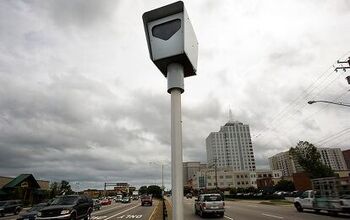Virginia: Rutherford Institute Takes on Red Light Cameras
A civil rights think tank on Friday urged Albemarle County, Virginia to cancel its red light program. In a letter to county supervisors, the Rutherford Institute made the case that the contract the county entered into with Australian vendor Redflex Traffic Systems violates the law and will likely not achieve the stated goal of reducing accidents.
“The Redflex contract incorporates a so-called ‘cost-neutrality’ provision whereby the company’s compensation, up to the amount of the contractual monthly fee, hinges on the number of violations or monetary penalties imposed,” the group’s president, John W. Whitehead, wrote. “Regardless of how the fee arrangement is worded or structured, it is likely to be found in violation of Virginia law where the vendor has a financial incentive to ensure that a high number of citations are issued.”
Virginia Code section 15.2-968 specifically bans compensation based on the number of violations issued. The Rutherford Institute provides free legal representation to individuals as a conservative alternative to the American Civil Liberties Union. The group also cited safety concerns raised by a number of independent studies of photo enforcement’s effectiveness ( view studies).
“The red light cameras are not proven to increase safety, and multiple studies indicate that they actually increase the number of crashes,” Whitehead wrote. “The hard evidence thus casts doubt on the claims that the purpose of the PhotoSafe program is to enhance traffic safety.”
In particular, the Virginia Department of Transportation concluded that accidents increased 29 percent in the Northern Virginia jurisdictions that used photo enforcement between 1995 and 2005 ( view study). It is impossible for Albemarle to have an accident reduction at one of the two intersections selected for camera use because it has never had a single “red light running” related crash ( view report). The institute suggested engineering alternatives would do more to increase safety.
“According to the National Highway Traffic Safety Administration, intersection safety would be increased by simply lengthening the yellow light time or adding an all-red light interval,” Whitehead wrote. “Rather than trading one type of crash for another as red light cameras do, increasing the duration of the yellow light is proven to be effective in actually enhancing intersection safety. Moreover, this cost-free means of achieving the county’s stated goal carries none of the costs to motorists’ privacy or community morale.”
The group concluded by pointing out that the Redflex marketing material highlights the expertise of the company in “generating more revenue” for local government, providing the strongest “return on investment” in the industry.
“It is clear that the ‘return on investment’ Redflex references is not an increase in traffic safety, but rather an increase in revenue generated by traffic offenses at the monitored intersections,” Whitehead wrote. “Whatever Albemarle County’s actual intentions are in this matter, Redflex’s stated goals for its system make the county’s business relationship with the company unseemly.”
The group asked county supervisors to re-evaluate the evidence and consider ending the red light camera program. A copy of the Rutherford Institute letter is available in a 275k PDF file at the source link below.
Albemarle County PhotoSafe Program Involving Red Light Cameras (Rutherford Institute, 12/3/2010)
[Courtesy: Thenewspaper.com]
More by The Newspaper
Latest Car Reviews
Read moreLatest Product Reviews
Read moreRecent Comments
- 3-On-The-Tree My 2009 C6 corvette in black looks great when it’s all washed and waxed but after driving down my 1.3 mile long dirt road it’s a dust magnet. I like white because dust doesn’t how up easily. Both my current 2021 Tundra and previous 2014 Ford F-150 3.5L Ecobomb are white
- Bd2 Would be sweet on a Telluride.
- Luke42 When will they release a Gladiator 4xe?I don’t care what color it is, but I do care about being able to plug it in.
- Bd2 As I have posited here numerous times; the Hyundai Pony Coupe of 1974 was the most influential sports and, later on, supercar template. This Toyota is a prime example of Hyundai's primal influence upon the design industry. Just look at the years, 1976 > 1974, so the numbers bear Hyundai out and this Toyota is the copy.
- MaintenanceCosts Two of my four cars currently have tires that have remaining tread life but 2017 date codes. Time for a tire-stravaganza pretty soon.


































Comments
Join the conversation
If the Rutherford Institute can get the spotlight focused on the heavily flawed ITE "Kell and Fullerton" equation, which is the root cause of the hideously dangerous short yellow light times, we're all not only going to get rid of the PhotoCASH cameras but end up with much safer and efficient traffic light-controlled intersections.
No reason to pay red light camera tickets in Virginia - unless you are served personally (i.e., deputy hands you the summons), there is no penalty for ignoring red light camera tickets mailed to you or tacked to your door. Let's get the word out - if localities know they will not make money on ticket scammeras, they will not enage in these accident producing schemes. See 2005 VDOT red light camera report at http://www.thenewspaper.com/rlc/docs/05-vdot.pdf: As the 2005 RLC VDOT report states in Appendix H: Virginia’s red light camera law “ultimately requires a personal notification, which may prove prohibitively expensive for some jurisdictions.” In more detail, the 2005 RLC VDOT report on page 110 explains this as follows: “The new statute referenced in section A., § 8.01-296, is the provision for service of process in civil actions, which has been borrowed by the Virginia General Assembly for the present purpose. It outlines several options for achieving satisfactory service, beginning with an attempt at personal in-hand service, and moving on to a series of de-escalating forms of substituted service: delivering to an adult at the defendant’s usual place of abode; posting on the front door of such abode in conjunction with mailing; and finally, by order of publication in appropriate cases under the provisions of the applicable code sections. It is the second of these that gives Virginia its nickname as a “nail and mail” state, meaning that for most civil actions, posting notice on the defendant’s front door in conjunction with mailing will constitute sufficient notice. However, this is not so for red light camera citations under the code, for the second statute referenced above is § 19.2-76 which, as we have already seen, requires personal in-hand service if the “nail and mail” approach does not succeed in bringing the defendant into court. Thus, under Virginia’s red light camera statute as it is now worded, the mere mailing of a citation without personal service by a law enforcement officer does not constitute sufficient notice under the statute’s own terms. While the statute permits the jurisdiction to make the initial attempt to summon the accused to court via mail, if that person fails to respond, he or she is not considered to have been satisfactorily served with notice. Default judgments entered under such circumstances (when the defendant fails to appear in court on the appointed return date) would thus not be binding, and the defendant could not be charged with contempt for failing to comply with such a judgment. Hence, despite its ostensive distancing from the requirements of Va. Code Ann. § 19.2-76, Virginia’s red light camera statute comes full circle and, in the end, requires personal service before a default judgment may be entered against no-shows.”